Common Torpedo
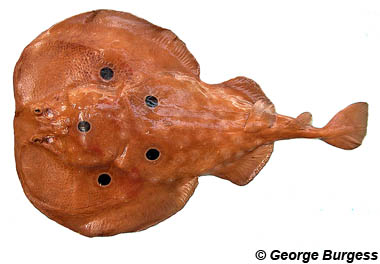
Torpedo torpedo
This small torpedo has an oval pectoral disc with a straight edge at the very front, an elongated body with rounded pelvic fins, and two small dorsal fins set back on its stout tail near its triangular caudal (tail) fin. It is white underneath, and reddish brown on top, with five dark blue spots ringed with dark and light accents.
The solitary nocturnal fish scavenges the shallow coastal sea floor for crustaceans and bony fish, using the kidney-shaped electric organs on either side of its head to stun its prey. Although it can only shock a human, because of its shallow habitat, caution should be used when possibly interacting with this torpedo.
Order – Torpediniformes
Family – Torpedinidae
Genus – Torpedo
Species – torpedo
Common Names
English language common names include common torpedo, cramp ray, crampfish, eyed electric ray, ocellate torpedo, and ocellated torpedo. Other common names include almindelig elrokke (Danish), arcisa (Italian), Augenfleck-Zitterrochen (German), baca (Spanish), crampo (Italian), darockka (Swedish), dourmillouse (French), dretwa pawik (Polish), drhtulja (Croatia), elektrik baligi (Turkish), elektrisk rokke (Danish), elektriskrocka (Swedish), flerfläckig darrocka (Swedish), formigón (Spain), galina (French), Gefleckter Zitterrochen (German), gevlekte sidderrog (Dutch), haddiela (Maltese), haddiela mtebba’ (Maltese), haddiela ta’ l’ghajnejn (Maltese), haddiela tal-ghajn (Maltese), matomoudiastra (Greek), meudj mbenjann (Wolof), moudiástra (Greek), narki (Greek), ortiga (Spanish), peshk elektrik (Albanian), peste electric (Rumanian), reguat argil (Arabic), renjok (Croatian), shibire-ei (Japanese), sidderrog (Dutch), strompigliola (Italian), tembla (Spanish), tembladeras (Spanish), temblador (Spanish), temblera (Spanish), torpedine (Italian), torpedine occhiuta (Italian), torpedine ocellata (Italian), torpila (Rumanian), torpille ocellée (French), torpille tachetée (French), trembladora (Spanish), tremedeira (Portuguese), tremelga (Portuguese), tremelga de olhos (Portuguese), tremielga (Spanish), tremielga de ojos (Spanish), tremmula liscia (Italian), tremmula ucchiata (Italian), tremoixe (Italian), tremoja (Italian), tremola (Italian), tremolina (Spanish), tremolo (Italian), tremoulina (French), tremula (Italian), tremula occhiuta (Italian), tremulina (Italian), triemele (Italian), trimielga (Spanish), trimmola (Italian), trippina (Italian), trompigliola (Italian), uyusturan (Turkish), vaca (Spanish), vaca comuna (Catalan), vaca trembladora (Spanish), and zitterrochen (German).
Importance to Humans
Although the common torpedo is edible, it is typically discarded when taken as bycatch in commercial and artisanal fisheries. Due to its shallow water habitats, the common torpedo often survives being captured and discarded. It is susceptible to demersal fishing gear such as bottom trawls and trammel nets and although fishing pressure is intense within its geographic range, there is no specific data on this species. This species can be maintained in aquariums, however it requires a supply of live fish for food.
Danger to Humans
The electric shock from the common torpedo is quite strong but is not life-threatening to humans.
Conservation
The IUCN is a global union of states, governmental agencies, and non-governmental organizations in a partnership that assesses the conservation status of species.
> Check the status of the common torpedo at the IUCN website.
Geographical Distribution
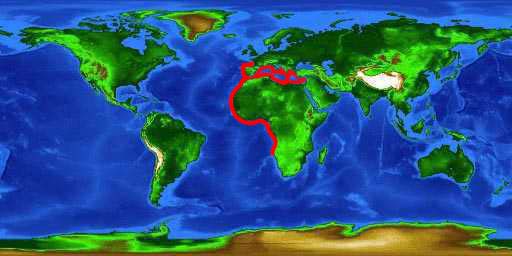
The common torpedo resides in the eastern Atlantic Ocean in the southern Bay of Biscay and throughout the Mediterranean to Angola.
Habitat
This demersal species prefers soft bottoms including sandy flats and seagrass beds, typically in inshore locations although it is occasionally observed in deeper waters. It is most commonly observed in tropical waters to 1,312 feet (400 m) in depth within its geographical range.
Biology
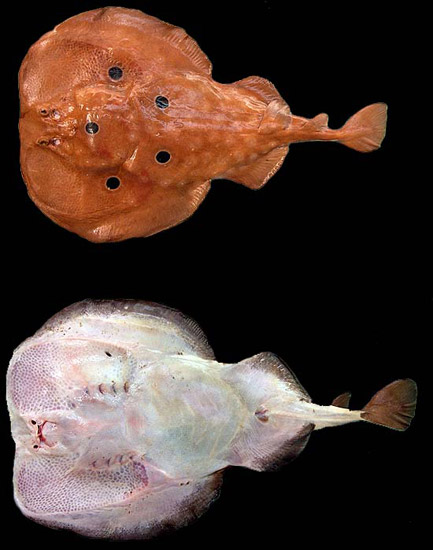
Distinctive Features
The disc of the common torpedo is circular in shape with a nearly straight front edge. The eyes and spiracles are small with the lateral and posterior rims of the spiracles possessing low knobs which tend to decrease in size as the individual ages.
Behind the spiracles, on the nape is a pair of mucous pores and on either side of the head are two large, kidney-shaped electric organs that are visible just beneath the skin. A wide, quadrangular flap of skin is located between the nostrils, almost reaching the mouth.
Five pairs of gill slits are located on the ventral side of the disc. The distinct pelvic fins have rounded outer margins and the short thick tail possesses skin folds along both sides with two dorsal fins located on the top, the first of which is slightly larger than the second. The caudal fin is triangular in shape with rounded corners and is roughly as long as the space between it and the first dorsal fin. The smooth skin lacks dermal denticles.
Coloration
The common torpedo has a disc-shaped body that is light to dark brown in color on the dorsal surface. Within this area are distinct large spots, also known as ocellae. Each spot is blue and circled by darker and lighter rings. Usually there are five ocellae in a symmetrical row of three and another row of two. Torpedos with less ocellae are uncommon and those with more than five are quite rare although not unknown. An individual was caught off of Tunisia with eight ocellae and another with nine off of southern France.
The ventral surface of the body is cream-colored and the margins of the disc are dark in color. There has been at least one documented albino specimen that was captured off the coast of Tunisia.
Dentition
The small teeth are arranged within the jaws in a dense quincunx patter, with 22-24 tooth rows in the upper jaw and 20-22 tooth rows in the lower jaw. Each tooth has a single sharp cusp.
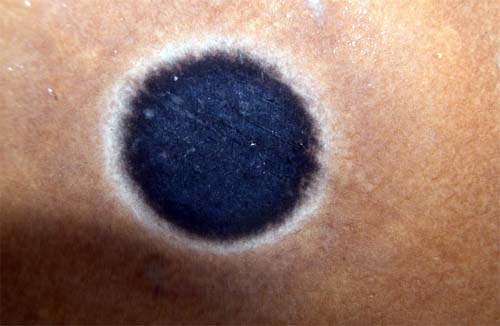
Size, Age, and Growth
The maximum reported length of a male common torpedo is 23.6 inches (60.0 cm) total length (TL) and 16.1 inches (41.0 cm) TL for a female specimen. However, this species more commonly reaches lengths of 11.8 inches (30 cm) TL (male) and 15.6 inches (39 cm) TL (female). Common torpedos reach larger sizes in waters off of Africa in comparison to those residing in the Mediterranean Sea.
Food Habits
Adult common torpedos feed primarily on benthic bony fish such as soles, herring, gobies, mullet, goatfish, porgies, dragonets, and jack mackerels. In addition, they are also known to occasionally eat crustaceans and even skates. In contrast, juveniles feed on a variety of marine invertebrates.
This species is solitary and nocturnal, living along the ocean floor often buried in sediments as it waits in hiding. As an ambush predator, it pounces on its prey and stuns it in a fraction of a second with an electrical current. Once the prey is stunned, the torpedo swallows it whole. The common torpedo can use its pair of large electric organs to stun prey and deter threats. Each organ is comprised of 400-500 columns that contain jelly-filled disks referred to as “electroplaques”. These columns work together and are capable of discharging up to 200 volts either singly or in bursts.
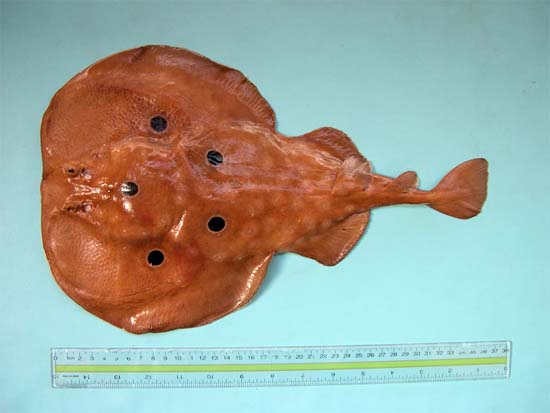
Reproduction
Reproduction is via aplacental viviparity in which the embryos are nourished by yolk and supplemental uterine milk also referred to as “histotroph” secreted by the mother. There is an annual cycle which is dependent upon geographic location. In the Mediterranean Sea, mating occurs from December through February with birth occurring from August to September following a 4-6 month gestation.
Up to 19 young are born per litter, measuring 3.1-3.8 inches (8.0-9.7 cm) long. In the waters off West Africa, gestation lasts 6-8 months with birth occurring from September through October. Litter sizes can number up to 28 young with the newborns measuring 4.0-4.9 inches (10.2-12.5 cm) in length. Litter size increases correspondingly with the size of the female.
Predators
Potential predators include larger marine fish such as sharks especially in cooler waters where it is unknown if the common torpedo’s electric organs are able to discharge a charge to deter predators.
Parasites
Known parasites of the common torpedo include the tapeworm Phyllobothrium lactuca and the monogeneans Amphibdella paronaperugiae and Amphibdelloides benhassinae.
Taxonomy
The common torpedo was originally described by Linnaeus as Raja torpedo in 1758 tenth edition of his Systema Naturae. In 1838, it placed under the Torpedo genus and assigned its currently valid scientific name of Torpedo torpedo by Bonaparte (Linnaeus 1838). Synonyms include Torpedo narce Risso 1810, Torpedo narke Risso 1810, Torpedo ocellata Rafinesque 1810, Torpedo unimaculata Risso 1810 and Torpedo oculata Davy 1834. Torpedo is the Roman name referring to electric rays with the Latin origin, torpere, meaning “to be numb”.
Prepared by: Cathleen Bester